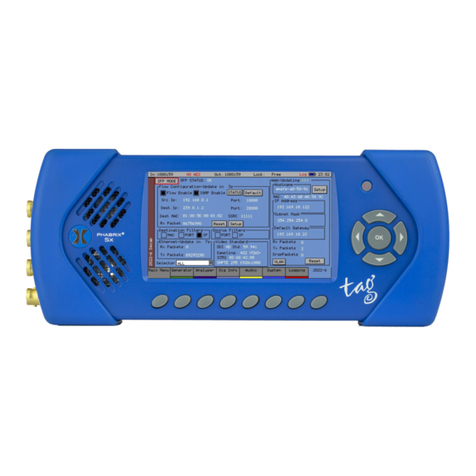
SxTAG Operation Manual ixPHSXT-200 3
Contents
Waveform Monitor ...................................................................................................... 2–20
Analyzer Source Selection ...................................................................................... 2–20
Sample, Line and Field Selection ............................................................................ 2–20
Waveform Type ...................................................................................................... 2–21
Magnification ......................................................................................................... 2–21
Cursors................................................................................................................... 2–21
Setup Button Dialogue ........................................................................................... 2–22
External Reference ................................................................................................. 2–22
Vectorscope................................................................................................................. 2–23
Analyzer Source Selection ...................................................................................... 2–23
Sample, Line and Field Selection ............................................................................ 2–23
Magnification ......................................................................................................... 2–24
Graticule ................................................................................................................ 2–24
Setup Button Dialogue ........................................................................................... 2–24
Composite Subcarrier Phase Alignment.................................................................. 2–24
Signal Data ................................................................................................................. 2–25
Analyzer Source Selection ...................................................................................... 2–25
Type ....................................................................................................................... 2–25
Signal Information Menu 2–27
Overview..................................................................................................................... 2–27
Video Status................................................................................................................ 2–27
EDH/CRC ERRORS.................................................................................................. 2–27
EDH DATA .............................................................................................................. 2–27
Cable Length .......................................................................................................... 2–28
Active Picture CRC.................................................................................................. 2–28
MISC Status ................................................................................................................ 2–29
Payload ID – SMPTE 352 ...................................................................................... 2–29
Video Format ......................................................................................................... 2–29
Video Timing ............................................................................................................... 2–30
ANC Status (ANC Option) ........................................................................................... 2–31
ANC Inspector (SDI Data Option) ................................................................................ 2–32
ANC Inspector Setup .............................................................................................. 2–33
Error Triggers ......................................................................................................... 2–33
SFP Info ...................................................................................................................... 2–34
Audio Menu 2–35
Meters ........................................................................................................................ 2–35
Audio Status ............................................................................................................... 2–36
Dolby Status (Dolby Analyzer Option) ......................................................................... 2–37
Overview ................................................................................................................ 2–37
Dolby E .................................................................................................................. 2–37
Dolby Digital .......................................................................................................... 2–37
Dolby Digital Plus................................................................................................... 2–38
Analyser Reference ................................................................................................ 2–38
Source selection ..................................................................................................... 2–38
Dolby E Framing Values ......................................................................................... 2–38
Dolby E Programme configuration.......................................................................... 2–39
Dolby Digital Programme configuration ................................................................. 2–40
Dolby Digital Plus Programme configuration .......................................................... 2–40
Programme Metadata............................................................................................ 2–41
Peak Metering........................................................................................................ 2–42
AES Eye (CVBS In) Option ........................................................................................... 2–43




























